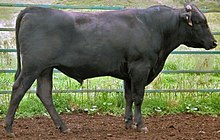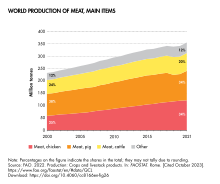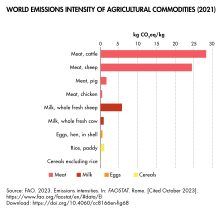
A | B | C | D | E | F | G | H | CH | I | J | K | L | M | N | O | P | Q | R | S | T | U | V | W | X | Y | Z | 0 | 1 | 2 | 3 | 4 | 5 | 6 | 7 | 8 | 9


Beef is the culinary name for meat from cattle (Bos taurus). Beef can be prepared in various ways; cuts are often used for steak, which can be cooked to varying degrees of doneness, while trimmings are often ground or minced, as found in most hamburgers. Beef contains protein, iron, and vitamin B12. Along with other kinds of red meat, high consumption is associated with an increased risk of colorectal cancer and coronary heart disease, especially when processed. Beef has a high environmental impact, being a primary driver of deforestation with the highest greenhouse gas emissions of any agricultural product.
In prehistoric times, humankind hunted aurochs and later domesticated them. Since that time, numerous breeds of cattle have been bred specifically for the quality or quantity of their meat. Today, beef is the third most widely consumed meat in the world, after pork and poultry. As of 2018, the United States, Brazil, and China were the largest producers of beef.
Some religions and cultures prohibit beef consumption, especially Indic religions like Hinduism. Buddhists and Sikhs are also against animal slaughtering, but they do not have a wrongful eating doctrine.
Etymology
The word beef is from the Latin word bōs,[1] in contrast to cow which is from Middle English cou (both words have the same Indo-European root *gʷou-).[2] After the Norman Conquest, the French-speaking nobles who ruled England naturally used French words to refer to the meats they were served. Thus, various Anglo-Saxon words were used for the animal (such as nēat, or cu for adult females) by the peasants, but the meat was called boef (ox) (Modern French bœuf) by the French nobles — who did not often deal with the live animal — when it was served to them.
This is one example of the common English dichotomy between the words for animals (with largely Germanic origins) and their meat (with Romanic origins) that is also found in such English word-pairs as pig/pork, deer/venison, sheep/mutton and chicken/poultry (also the less common goat/chevon).[3] Beef is cognate with bovine through the Late Latin bovīnus.[4] The rarely used plural form of beef is beeves.[5]
History
People have eaten the flesh of bovines since prehistoric times; some of the earliest known cave paintings, such as those of Lascaux, show aurochs in hunting scenes.[6] People domesticated cattle to provide ready access to beef, milk, and leather.[7] Cattle have been domesticated at least twice over the course of evolutionary history. The first domestication event occurred around 10,500 years ago with the evolution of Bos taurus. The second was more recent, around 7,000 years ago, with the evolution of Bos indicus in the Indian subcontinent. There is a possible third domestication event 8,500 years ago, with a potential third species Bos africanus arising in Africa.[8]
In the United States, the growth of the beef business was largely due to expansion in the Southwest. Upon the acquisition of grasslands through the Mexican–American War of 1848, and later the expulsion of the Plains Indians from this region and the Midwest, the American livestock industry began, starting primarily with the taming of wild longhorn cattle. Chicago and New York City were the first to benefit from these developments in their stockyards and in their meat markets.[9]
Production



Beef cattle are raised and fed using a variety of methods, including feedlots, free range, ranching, backgrounding and intensive animal farming. Concentrated Animal Feeding Operations (CAFOs), commonly referred to as factory farms, are commonly used to meet the demand of beef production. CAFOs supply 70.4% of cows in the US market and 99% of all meat in the United States supply.[10] Cattle CAFOs can also be a source of E. coli contamination in the food supply[11] due to the prevalence of manure in CAFOs. These E. coli contaminations include one strain, E. coli O157:H7, which can be toxic to humans, because cattle typically hold this strain in their digestive system.[12] Another consequence of unsanitary conditions created by high-density confinement systems is increased use of antibiotics in order to prevent illness.[13] An analysis of FDA sales data by the Natural Resources Defense Council found 42% of medically important antibiotic use in the U.S. was on cattle, posing concerns about the development of antibiotic resistant bacteria.[14] In 2023 production was forecast to peak by 2035.[15]
Environmental impact

| Food Types | Greenhouse Gas Emissions (g CO2-Ceq per g protein) |
|---|---|
| Ruminant Meat | 62
|
| Recirculating Aquaculture | 30
|
| Trawling Fishery | 26
|
| Non-recirculating Aquaculture | 12
|
| Pork | 10
|
| Poultry | 10
|
| Dairy | 9.1
|
| Non-trawling Fishery | 8.6
|
| Eggs | 6.8
|
| Starchy Roots | 1.7
|
| Wheat | 1.2
|
| Maize | 1.2
|
| Legumes | 0.25
|
| Food Types | Land Use (m2year per 100g protein) |
|---|---|
| Lamb and Mutton | 185
|
| Beef | 164
|
| Cheese | 41
|
| Pork | 11
|
| Poultry | 7.1
|
| Eggs | 5.7
|
| Farmed Fish | 3.7
|
| Groundnuts | 3.5
|
| Peas | 3.4
|
| Tofu | 2.2
|
The consumption of beef poses numerous threats to the natural environment. Of all agricultural products, beef requires some of the most land and water, and its production results in the greatest amount of greenhouse gas emissions (GHG),[18] air pollution, and water pollution.[19] A 2021 study added up GHG emissions from the entire lifecycle, including production, transportation, and consumption, and estimated that beef contributed about 4 billion tonnes (9%) of anthropogenic greenhouse gases in 2010.[20]: 728 Cattle populations graze around 26% of all land on Earth, not including the large agricultural fields that are used to grow cattle feed.[21][22] According to FAO, "Ranching-induced deforestation is one of the main causes of loss of some unique plant and animal species in the tropical rainforests of Central and South America as well as carbon release in the atmosphere."[23] Beef is also the primary driver of deforestation in the Amazon, with around 80% of all converted land being used to rear cattle.[24][25][26] 91% of Amazon land deforested since 1970 has been converted to cattle ranching.[21][27] 41% of global deforestation from 2005 to 2013 has been attributed to the expansion of beef production.[28] This is due to the higher ratio of net energy of gain to net energy of maintenance where metabolizable energy intake is higher.[29] The ratio of feed required to produce an equivalent amount of beef (live weight) has been estimated at 7:1 to 43:1, compared with about 2:1 for chicken.[30][31][32] However, assumptions about feed quality are implicit in such generalizations. For example, production of a kilogram of beef cattle live weight may require between 4 and 5 kilograms of feed high in protein and metabolizable energy content, or more than 20 kilograms of feed of much lower quality.[29] A simple exchange of beef to soy beans (a common feed source for cattle) in Americans' diets would, according to one estimate, result in meeting between 46 and 74 percent of the reductions needed to meet the 2020 greenhouse gas emission goals of the United States as pledged in 2009.[33][needs update] A 2021 CSIRO trial concluded that feeding cattle a 3% diet of the seaweed Asparagopsis taxiformis could reduce the methane component of their emissions by 80%.[34][35] While such feed options are still experimental, even when looking at the most widely used feeds around the globe, there is high variability in efficiency.[36] One study found that shifting compositions of current feeds, production areas, and informed land restoration could enable greenhouse gas emissions reductions of 34–85% annually (612–1,506 MtCO2e yr−1) without increasing costs to global beef production.[37]
Some scientists claim that the demand for beef is contributing to significant biodiversity loss as it is a significant driver of deforestation and habitat destruction; species-rich habitats, such as significant portions of the Amazon region, are being converted to agriculture for meat production.[38][39][40] The 2019 IPBES Global Assessment Report on Biodiversity and Ecosystem Services also concurs that the beef industry plays a significant role in biodiversity loss.[41][42] Around 25% to nearly 40% of global land surface is being used for livestock farming, which is mostly cattle.[41][43]
Certifications
Some kinds of beef may receive special certifications or designations based on criteria including their breed (Certified Angus Beef,[44] Certified Hereford Beef), origin (Kobe beef,[45] Carne de Ávila, Belgian Blue[46]), or the way the cattle are treated, fed or slaughtered (organic, grass-fed, Kosher, or Halal beef[47]). Some countries regulate the marketing and sale of beef by observing criteria post-slaughter and classifying the observed quality of the meat.
Global statistics

In 2018, the United States, Brazil, and China produced the most beef with 12.22 million tons, 9.9 million tons, and 6.46 million tons respectively.[48] The top 3 beef exporting countries in 2019 were Australia (14.8% of total exports), the United States (13.4% of total exports), and Brazil (12.6% of total exports).[49] Beef production is also important to the economies of Japan, Argentina, Uruguay, Canada, Paraguay, Mexico, Belarus and Nicaragua.
Top 5 cattle and beef exporting countries
As per 2020, Brazil was the largest beef exporter in the world followed by Australia, United States, India (Includes Carabeef only) and Argentina.[50] Brazil, Australia, the United States and India accounted for roughly 61% of the world's beef exports.[51]
| Rank | Country | 2020 | % of the World[53] | Country | 2016 | % of the World |
|---|---|---|---|---|---|---|
| 1 | Brazil | 2,539,000 | 23.50% | Brazil | 1,850,000 | 19.60% |
| 2 | Australia | 1,476,000 | 13.66% | India | 1,850,000 | 19.60% |
| 3 | United States | 1,341,000 | 12.41% | Australia | 1,385,000 | 14.67% |
| 4 | India | 1,284,000 | 11.88% | United States | 1,120,000 | 11.87% |
| 5 | Argentina | 819,000 | 7.58% | New Zealand | 580,000 | 6.14% |
Top 10 cattle and beef producing countries
The world produced 60.57 million metric tons of beef in 2020, down 950K metric tons from the prior year. Major decline for production of beef was from India up to 510k and Australia down to 309K metric tons from the prior year.[54]
| Rank | Country | 2009 | 2010 | % Chg | Country | 2019 | 2020 | Change | %Chg |
|---|---|---|---|---|---|---|---|---|---|
| 1 | United States | 11,889 | 11,789 | −0.8% | United States | 12,384 | 12,379 | -5,000 | -0.04% |
| 2 | Brazil | 8,935 | 9,300 | 4% | Brazil | 10,200 | 10,100 | -100,000 | Zdroj:https://en.wikipedia.org?pojem=Beef
